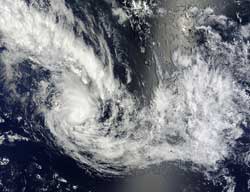NASA Eyes the Birth of Tropical Cyclone Haley

On Feb. 9 at 2020 UTC the MODIS instrument aboard NASA's Terra satellite captured this visible image of Tropical Cyclone Haley (14P) in the South Pacific Ocean. Credit: NASA Goddard MODIS Rapid Response Team <br>
On Feb. 9 at 2020 UTC (3:20 p.m. EST) the Moderate Resolution Imaging Spectroradiometer (MODIS) instrument aboard NASA's Terra satellite captured a visible image of System 93P (known in Fiji as 14F). The MODIS image showed a circular center of circulation with banding features, two things that indicated that the low pressure area was quickly organizing. The next day, the low became Tropical Storm Haley.
Tropical Cyclone Haley formed on Feb. 10 at 0300 UTC, about 325 nautical miles (374 miles 602 km) south-southwest of Bora Bora, Society Islands, French Polynesia, in the open waters of the South Pacific Ocean. Maximum sustained winds strengthened quickly to 45 knots (51.7 mph/83.3 kph). Soon after Haley intensified, infrared satellite imagery indicated that convection (rising air that forms thunderstorms that make up the storm) were already weakening around the center.
On Feb. 11 at 0300 UTC, the Joint Typhoon Warning Center issued its final advisory on Tropical Cyclone Haley. At that time, Haley's center was located near 24.8 south latitude and 150.0 west longitude, about 500 nautical miles (575.4 miles/926 km) southeast of Bora Bora, Society Islands. Haley was moving to the southeast at 11 knots (12.6 mph/20.3 kph). As a result of wind shear and cooler sea surface temperatures, Haley's maximum sustained winds had already dropped to 35 knots (40.2 mph/64.8 kph).
The forecasters at the Joint Typhoon Warning Center expect Haley to continue moving southeast as wind shear increases and sea surface temperatures become even cooler. Both of those factors are expected to dissipate Haley by Tuesday, Feb. 12.
Text Credit: Rob Gutro
NASA's Goddard Space Flight Center
Media Contact
All latest news from the category: Earth Sciences
Earth Sciences (also referred to as Geosciences), which deals with basic issues surrounding our planet, plays a vital role in the area of energy and raw materials supply.
Earth Sciences comprises subjects such as geology, geography, geological informatics, paleontology, mineralogy, petrography, crystallography, geophysics, geodesy, glaciology, cartography, photogrammetry, meteorology and seismology, early-warning systems, earthquake research and polar research.
Newest articles

Superradiant atoms could push the boundaries of how precisely time can be measured
Superradiant atoms can help us measure time more precisely than ever. In a new study, researchers from the University of Copenhagen present a new method for measuring the time interval,…

Ion thermoelectric conversion devices for near room temperature
The electrode sheet of the thermoelectric device consists of ionic hydrogel, which is sandwiched between the electrodes to form, and the Prussian blue on the electrode undergoes a redox reaction…

Zap Energy achieves 37-million-degree temperatures in a compact device
New publication reports record electron temperatures for a small-scale, sheared-flow-stabilized Z-pinch fusion device. In the nine decades since humans first produced fusion reactions, only a few fusion technologies have demonstrated…





















